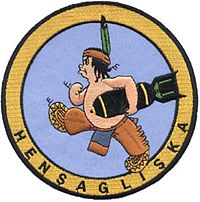- VMA-144
-
Marine Attack Squadron 133 
VMSB/VMTB-144 InsigniaActive September 7, 1942 - December 9, 1945
reactivated as reserve squadronCountry United States Branch USMC Type Fighter squadron Role Close air support
Air interdictionPart of Inactive Nickname Hensagliska
(In Sioux this translates to "Little Warrior, Brave Warrior")[1]Tail Code 6F Engagements World War II
* Battle of Guadalcanal
* Bougainville campaign (1943-45)Aircraft flown Attack A-4 Skyhawk Bomber SBD Dauntless
TBF AvengerMarine Attack Squadron 144 (VMA-144) was a reserve A-4 Skyhawk fighter squadron in the United States Marine Corps. Originally known as VMSB-144, the squadron saw its first combat in World War II as part of the Cactus Air Force during the Battle of Guadalcanal and also provided close air support during the Bougainville campaign (1943-45). Following the war the squadron was deactivated but later became part of the Marine Air Reserve and was based out of Naval Air Station Jacksonville and then Naval Air Station Cecil Field, Florida.
Contents
History
World War II
Marine Scout Bomber Squadron 144 (VMSB-144) was formed at Naval Air Station San Diego on September 7, 1942. They remained in California for training until early 1943 when they departed for the South Pacific, travelling through Noumea and Efate, where the ground echelon remained. The squadron's flight echelon landed at Henderson Field on Guadalcanal on February 5, 1943. They returned from their first combat tour on March 12, 1943. The entire squadron returned to Guadalcanal on June 13, 1943. The flight echelon moved to the Russell Islands for the month of July, returning to Henderson Field and then moving to Efate again. The squadron's flight echelon moved to Munda on October 15, 1943 and from November 1 to November 21, they provided close air support to troops during the Battle of Bougainville. On January 12, 1944, the squadron boarded ship to begin their return to the United States[2].
 A VMSB-144 SBD Dauntless over the landing beach at Torokina.
A VMSB-144 SBD Dauntless over the landing beach at Torokina.
The squadron relocated to Marine Corps Air Station El Toro, California[3] and was redesignated as Marine Torpedo Bomber Squadron 144 (VMTB-144) on October 14, 1944[1]. A month later, on November 5, they were again redesignated as VMTB-144(CVS) as they trained to operate from the Navy's escort carriers[4]. In December 1944, the squadron moved to Marine Corps Air Station Mojave, California to continue training[5]. During this time their designation was also reverted back to VMTB-144[4]. In June 1945, VMTB-144 moved to Marine Corps Air Station Santa Barbara, California where they stayed until August 12, 1945 when they reported aboard the USS Salerno Bay (CVE-110). Following the end of the war, the squadron returned to Marine Corps Air Station Miramar and was deactivated on December 9, 1945[1]
Reserve years
Sometime after the war, the squadron was reactivated as Marine Attack Squadron 144 (VMA-144) and were part of the Marine Air Reserve and based out of Naval Air Station Jacksonville and then Naval Air Station Cecil Field, Florida.
See also
- United States Marine Corps Aviation
- List of active United States Marine Corps aircraft squadrons
- List of inactive United States Marine Corps aircraft squadrons
Notes
References
- Bibliography
- Rottman, Gordon L. (2002). U.S. Marine Corps World War II Order of Battle - Ground and Air Units in the Pacific War, 1939 - 1945.’’. Greenwood Press. ISBN 0-313-31906-5.
- Sherrod, Robert (1952). History of Marine Corps Aviation in World War II. Washington, D.C.: Combat Forces Press.
- Shettle Jr., M. L. (2001). United States Marine Corps Air Stations of World War II. Bowersville, Georgia: Schaertel Publishing Co.. ISBN 0-964-33882-3.
- Web
Categories:- United States Marine Corps fixed wing squadrons
- Inactive units of the United States Marine Corps
Wikimedia Foundation. 2010.

